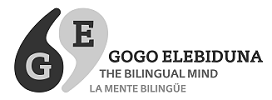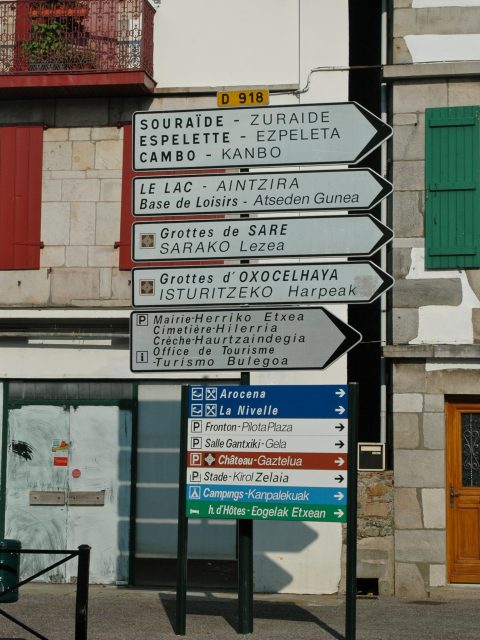How do bilinguals control their languages?


Talking seems easy to us, so much so that we take it for granted, but the cognitive machinery responsible for this capacity is extremely complex. Among the many cognitive processes involved in speaking, people who know more than one language face an added challenge: they not only need to ensure that the words they select correspond to what they intend to say, as all speakers do, they must also make sure that what they say belongs in the language they want to use. How do they do it?
The most revealing findings of how bilinguals control their languages have been provided by Albert Costa and his collaborators, in a series of experiments. These studies employ what is known as the language-switching task: participants have to name pictures alternating their two languages, and the pictures carry a cue indicating the language in which the corresponding word has to be said. In the studies discussed here, the cue was the color of the picture: the participant had to use language A if the picture was blue and language B if the picture was red. Pictures were arranged in such a way that in some occasions a given picture was named in the same language as the previous one (a condition known as “non-switch trial”), but in others the picture had to be named in a language different from the previous one (a condition known as “switch trial”). Researchers then time how long it takes to name the incoming picture in the first vs. the second situation: the time difference between switch and non-switch trials reflects the cognitive cost of switching from one language to another.
These experiments, carried out with various types of bilinguals (of Basque, Catalan, English, French and Spanish) show that unbalanced bilinguals were one language is clearly dominant over the other take longer to switch from their less dominant non-native language to their native one than the other way around. This result had been initially reported in a pioneering study by Meuter and Allport 1 who explored language control with bilinguals who were not very proficient in their second language, and hit upon the seemingly paradoxical result: people took longer to switch back to their native and dominant language than to the language they knew and used less. This asymmetrical switching cost pattern was accounted for in terms of the cognitive effort it takes to inhibit the language not in use because inhibiting a dominant language uses greater cognitive resources than inhibiting a weaker one. Undoing the effects of inhibition will hence take longer in the case were greater efforts have been put to work, yielding the asymmetrical pattern in language switch. According to this view, language control in bilinguals entails the active inhibition of the linguistic representations of the other language, which, despite being activated, is not intended to be used.
Costa, Santesteban and Ivanova2 pursued the question of language control by including true bilinguals, that is, people who learned both languages in childhood, know them well and use them frequently throughout life. If the inhibition effort explanation for the asymmetrical switching cost is correct, then balanced bilinguals should not present an asymmetrical pattern when changing from one language to another. Indeed, Costa and colleagues discovered that given the same language-switching tasks, these bilinguals incurred in symmetrical switching costs. That is, it took them the same time to switch from either of their two languages to the other.
This symmetrical pattern could be accounted for within the general language inhibition account. But what Costa and colleagues found next revealed that early and proficient bilinguals employ qualitatively different mechanism for language control, distinct from inhibition. Surprisingly, the mechanism employed by these balanced bilinguals yielded a symmetrical pattern not only when switching between the two languages they had known and used throughout their lives, but also when they had to switch to and form a third language they had learned much later and knew less. So, while the switching performance of low-proficient bilinguals leads to an asymmetrical pattern dependent on language dominance, in early and proficient bilinguals it always yields a symmetric pattern, regardless of dominance, age of learning or proficiency.
Are these early bilinguals using different brain areas to change from one language to the other? The neural underpinnings of language control in bilinguals are still not understood in detail, though much progress has been made in identifying them during these last years. Garbin et al. 3 4 foundthat early and proficient bilinguals, unlike monolinguals and late bilinguals, recruit Broca’s area for language switching. Moreover, these researchers found significant differences in the cortical networks involved in cognitive control between monolinguals and bilinguals: the most interesting difference is the involvement of Broca’s area also in non-linguistic switch tasks for bilinguals, whereas monolinguals activated the right hemisphere for the same switch tasks. The fact that the left Inferior Frontal Gyrus (Broca’s area) has been consistently related to bilingual language control suggests that in bilinguals, but not in monolinguals, there is a certain degree of overlap between the cortical network responsible for language control and general-purpose non-linguistic cognitive control. This means that early and proficient bilinguals recruit Broca’s area not only for language switching tasks, but also for other non-linguistic switch tasks. These results thus suggest that although the attentional mechanisms that are better developed in bilinguals are not language-specific (because they also monitor other types of tasks where language is not involved) and although in non-bilinguals these attentional mechanisms are controlled by bi-hemispheric or right-hemispheric regions of the brain, in bilinguals they are controlled and computed by Broca’s area (Brodman 45/44), one of the areas crucially involved in linguistic computation. Martin et al. 5 looked at the electrophysiological signature related to language switch in early vs. late bilinguals when both groups had to switch to and from a third late learned language (L3). Results revealed a different electrophysiological signature for each group. Even though the relative strength of languages was similar in both groups (a dominant and a weak late acquired language), they controlled their language output in a qualitatively different manner, in convergence with the findings in Costa, Santesteban and Ivanova (2006).
What these studies reveal, then, is that there is a qualitative difference between bilinguals that learn their languages early, know them well and use them on a daily basis and those who learn a second language later in life and use it far less frequently than their native dominant language. Early and fluent bilinguals develop a distinct neurocognitive strategy or mechanism to control the languages they know, and they recruit Broca’s area to do it. Late and less fluent bilinguals employ the mechanisms and neural substrates normally related to task switch also in monolinguals. This is why even when involving a language learned late and not frequently used, early bilinguals continue to employ the same and more efficient switch mechanism. Could this be part of the reason why early bilinguals are said to be better at learning a third language? Probably so, stay tuned for more.
References
- Meuter, R. F. I., & Allport, A. (1999). Bilingual language switching in naming: Asymmetrical costs of language selection. Journal of Memory and Language, 40, 25–40. ↩
- Costa, A., Santesteban M., Ivanova I. (2006) How do highly proficient bilinguals control their lexicalization process? Inhibitory and Language-Specific Selection mechanisms are both functional. Journal of Experimental Psychology: Learning, Memory and Cognition, 32, 1057-1074. ↩
- Garbin, G., Sanjuan, A., Forn, C., Bustamante, J.C., Rodriguez-Pujadas, A., Belloch, V., Hernandez, M., Costa, A., Ávila C. (2010) Bridging language and attention: Brain basis of the impact of bilingualism on cognitive control. NeuroImage 53, 1272–1278 ↩
- Garbin, G., Costa, A., Sanjuan, A., Forn, C., Rodriguez-Pujadas, A., Ventura, N., Belloch, V., Hernandez, M., Ávila, C. (2011). Neural bases of language switching in high and early proficient bilinguals Brain and Language 119 (3), pp. 129-135 ↩
- Martin C.D., Strijkers K., Santesteban M., Escera C., Hartsuiker R.J. & Costa A. (2013). The impact of early bilingualism on controlling a language learned late: an ERP study, Frontiers in Psychology, 4 DOI: 10.3389/fpsyg.2013.00815 ↩
5 comments
Very interesting post. Both me and my husband are bilingual (Catalan/Spanish and Basque/Spanish, respectively) and we are raising trilingual children (Catalan/Spanish/English). Despite the initial mixing of all three languages, we observed that, all of a sudden, something changes in the child’s mind and they are able to differentiate each language and use it according to the situation: Spanish with dad, Catalan with mom, English at school. They can also switch between languages very quickly when having a family conversation. Soon we will face the introduction to a fourth language, and see if it is easier for them to learn it. Let’s hope it is!
Thank you! My daughter is also trilingual, and I can relate to much of what you say. Despite appearances, children do not “mix” languages in their minds; in fact they discriminate the languages around them at a very early age. I will write one entry about early language discrimination in infants, it is full of surprises!
Fantastic, Carol
As a language practitioner, I like this article and it is touchy to me. I suggest people more especially Namibians need to read this loudly to establish the understanding regarding the differences in languages. Carol may I send this article for publishing in the newspaper?
Scholastika.
[…] English), the communicative importance of function words like articles and prepositions, and or how “balanced” and “unbalanced” bilinguals use different parts of their bra… (perhaps related to why I become no-lingual after switching from primary English- to Spanish-usage […]
Hello Itziar!
I’m a student in Linguistics and I ran into this article while searching for some explanation of how the brain works when bilingualism is involved, since I have no notion of “technical” brain functioning. I have a few questions, which may sound odd, since, as I said, I’m new to this field.
1) I read in earlier comments that children do not “mix” languages in their minds. Is this true for bilinguals in general? And what about L2 learners? I’m currently trying to figure something out of Myers-Scotton’s Matrix Language Model for code-switching, and she states that speakers may produce structures whose source is split between two or more languages, i.e. their utterances may come from a “composite frame” in their minds; this can happen in second-language learning and in creole formation as well as “in various situations [when] speakers may need to avoid using their L1 […] or they may be shifting from their L1 to a more dominant language in their community.” Can this “composite frame” be possible at a cognitive level?
2) This question comes out of curiosity from my personal experience: is it possible for a bilingual person to lose the ability of switching from one language to the other (specifically, in a case of unbalanced bilingualism, from the L2 back to the L1)? My grandmother used to switch frequently forth and back between Italian and Piedmontese (her native language, local “dialect”, in which she was more proficient and fluent) until a few years ago. Now she only speaks Italian and she would admittedly say “I forgot Piedmontese.” Since she suffered twice from ischemia, I wonder: although it seemed that the language production process had not been damaged by that stroke, could her bilingual ability of switching, instead, have been affected by it?